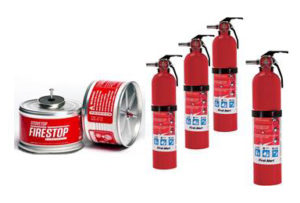Fire Safety Tips for Your Home

Fire Extinguishers
Fire extinguishers are one of the most important safety tools you can, and should own. They can be a lifesaver when the right type is available and used properly.
All household extinguishers are classified as either A, B, or C (or a combination of these) on the label to indicate which types of fires you can use them on. Most of the types sold at home improvement centers are classified as ‘A’, ‘B’ or ‘C’ and fight the three most common types of residential fires:
- Ordinary combustibles (paper, wood, clothing, etc.)
- Flammable liquids (grease, oil gasoline, paint)
- Electrical
Home use fire extinguishers come in varying sizes; rule of thumb is the bigger the better, but that may not be practical in every situation. The bigger the extinguisher, the heavier and bulkier they are. Note: The weight on an extinguisher label refers to the amount of chemical inside. Add roughly 3-5 pounds to that for the average size bottle. Fire extinguishers are also offered in two other standard configurations, rechargeable or disposable. Rechargeable extinguishers will be outfitted with metallic valves while disposable bottles will have valves made typically of plastic.
A rechargeable fire extinguisher generally costs more, but refilling it once the pressure gauge-indicator reads ‘undercharged’ (generally RED on the dial), is still less expensive than buying a new disposable one.
The National Fire Protection Association recommends at least one ‘proper type’ extinguisher for each floor, placed near an exit, and/or an easy-to-grab location. Be sure to train each adult in the home on the proper use, storage and care of your extinguishers. It is not recommended that young children be allowed to use extinguishers; focus on training them to follow the instructions of the adults and removing themselves from harm’s way in the event of a fire. Be sure to develop and periodically review an escape plan for your family and that everyone knows how to get out in a hurry, where to meet outside, and how to call for emergency services (911).
Even if you think you’ve put out the fire on your own and don’t see anything burning, don’t assume and DO NOT cancel that emergency services call. Leave it to the professionals to make that determination!
Understanding Extinguishers and their Labels
Every household extinguisher is labeled A, B, or C, which tells you the types of fires the extinguisher is most effective against.
In the fine print on the extinguishers label, these letters are preceded by numbers, which represent the extinguishers classification rating. For example, 3-A:40-B:C. The classification numbering is assigned by Underwriters Laboratories and provides the extinguisher’s relative effectiveness against each type of fire, regardless of its weight or the chemical it uses; the higher the number, the greater the effectiveness. For example, an extinguisher with a 4-A rating is more effective on ordinary combustibles than one with a 2-A rating. The ‘C’ designation carries no number; it just means the extinguisher’s chemicals won’t conduct electricity.
Choosing the Right Size
10-pound
Best for: Garage or home workshop, where a fire might grow in size before being noticed.
5-pound
Best for: Quick grab in the kitchen or laundry room.
2-pound
Best for: Car.
Look for: Disposable model with mounting hardware to keep it from rolling around in the trunk.
Stove-top Model (http://stovetopfirestop.com/)
Best for: Mounting on range hood over stove. (Do not use over deep fryers; released chemical can splash grease and spread flames.)
Look for: Magnetic pressurized cans designed to pop open from the heat of flames, spraying sodium bicarbonate (baking soda).
Additional Resources:
National Fire Protection Association (NFPA)
